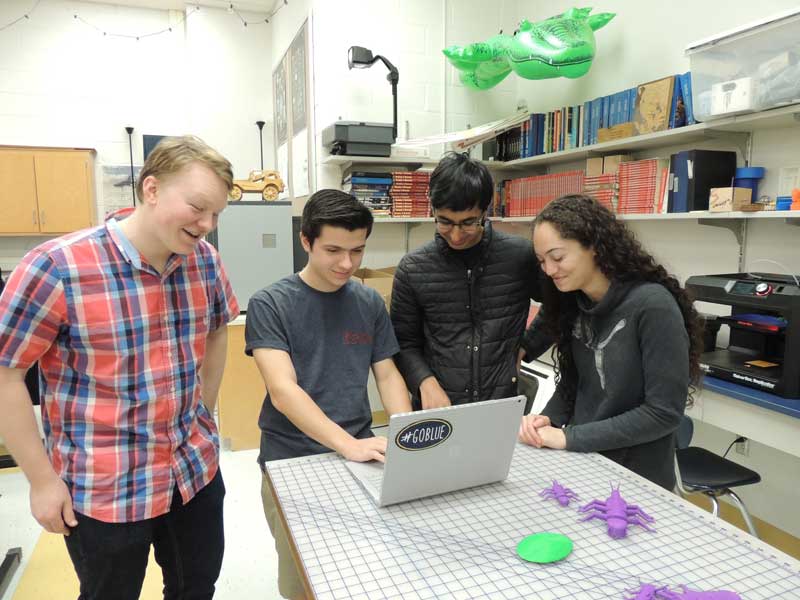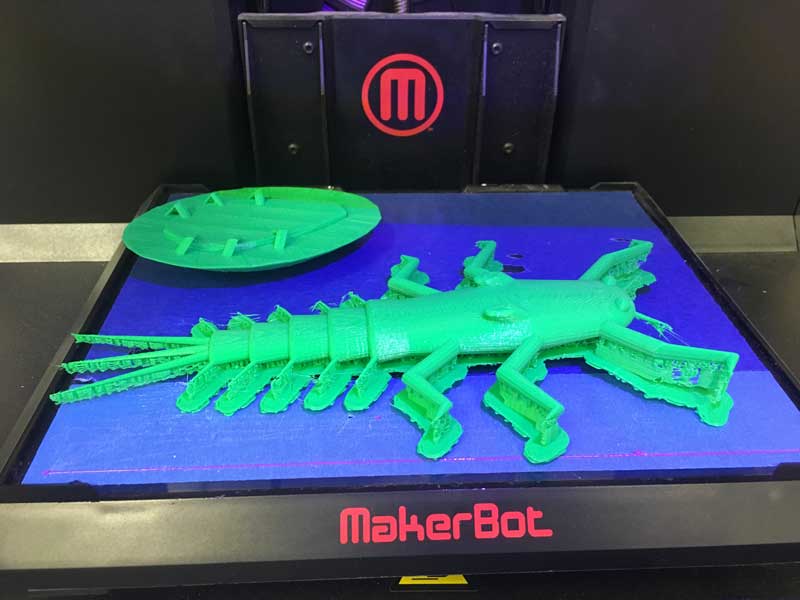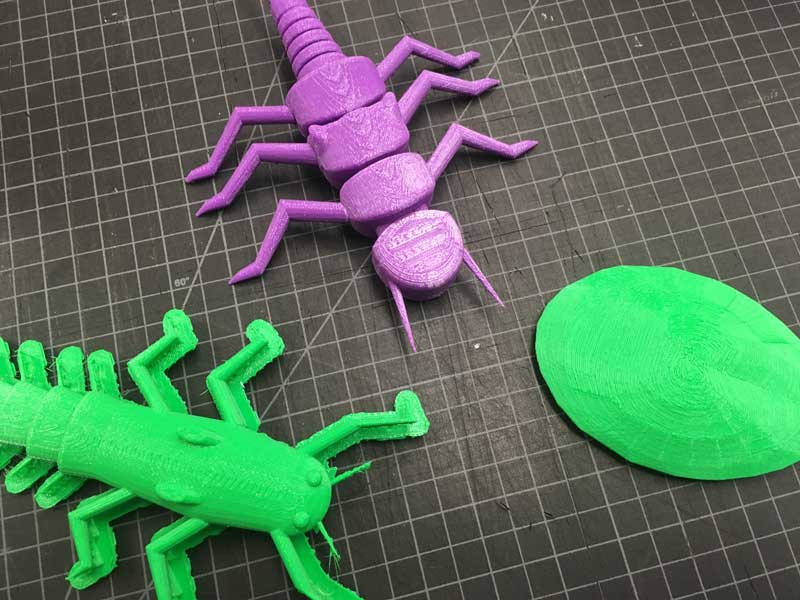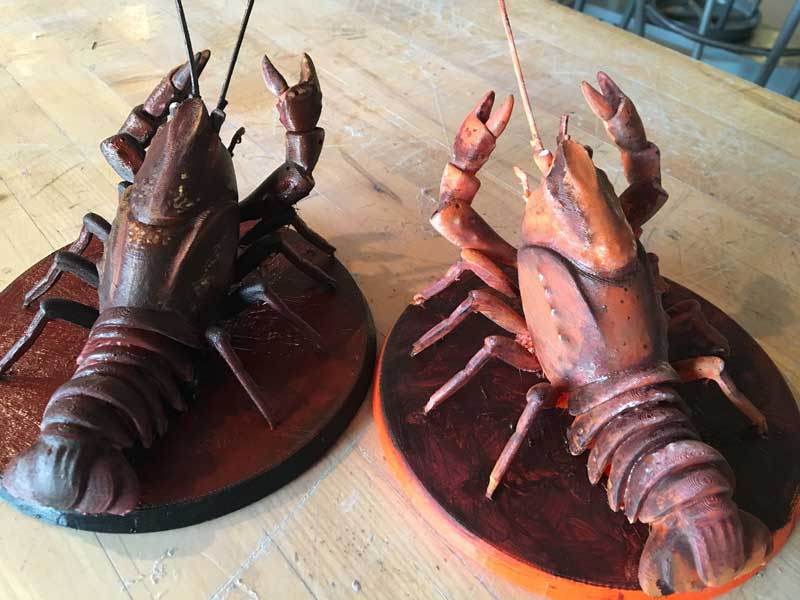The 3D printable macroinvertebrate designs featured in this article are now available as free downloads from Thingiverse.com.
By Diane Huskinson (A version of this article first appeared in County Lines Magazine.)
Vince O’Donnell retired from Unionville High School five years ago, but he’s still, and likely always will be, a teacher. After a 45-year career teaching biology and only a few years into retirement, O’Donnell got the itch to return to what he loved. So he joined Stroud Water Research Center as a part-time educator in 2016, just as Education Director Steve Kerlin began expanding the Stroud Center’s environmental education programs for students and teachers.
A Real-Life Project
Always looking for new ways to help students learn, O’Donnell had an idea: “We couldn’t find any three-dimensional models of the critters that live in streams to use as a teaching tool, but a former colleague reminded me Unionville High School has 3-D printers.” O’Donnell reached out to the school’s tech ed department, and four of Steve Ortega’s engineering students volunteered.

Bryan Denmark, a junior in Ortega’s computer integrated manufacturing class, said, “I wasn’t sure what I was getting into at first, but I was up for the challenge.” After learning more, he realized it was an opportunity to apply skills he had learned in class to a real-life project.
It was also a chance to learn new skills. “Most of the time, the parts we create in class are more along the lines of machine parts, brackets, or fixtures. They tend to be more angular. The objects for this project have complex curves, layers, and parts intersecting at angles they haven’t dealt with before,” Ortega explained.
Denmark, who is modeling a mayfly nymph, added, “I feel like this project has been a wonderful taste of what an actual engineer would do.”
O’Donnell continues to meet with the students to follow their progress, review mockups, and provide feedback. At the start, he pointed them to resources such as macroinvertebrates.org and the WaterQuality mobile app, one of the six tools that make up the Stroud Center’s WikiWatershed toolkit. The students did their own research to learn how the models should look, and each student accepted one macroinvertebrate to model in addition to a crayfish.
Junior Sebastian Graper said, “Working on the water penny larva, I spent what must have been hours on getting the back curved to mirror the actual bug.” It’s a long process, and the project will likely continue into next school year.
Integrating Art and Science
Because it takes five to eight hours to print one model, the students set the printers to run overnight, and the mockups are ready when they arrive back at school the next morning.


“Once I saw the mockups, I thought why not get the art department involved too. Then you’ve got integration between the departments within the school, which is always encouraged,” said O’Donnell. This approach mirrors how scientists and educators at the Stroud Center work, across disciplines and inspired by the natural world as well as art. The Stroud Center’s founders firmly believed in integrating art and science.
Three of Faith Dilworth’s art students, all members of the National Art Honor Society, jumped at the chance to add real-life colors and textures to the models. “It is a perfect marriage of science, technology, and fine art,” Dilworth said. “The students were excited not only by the fact that their peers had actually created the models, but that their painted surface application would be integral to other students being able to learn about the science of these organisms through the Stroud Center’s education programs.”
It’s also an opportunity, Dilworth explained, for the students to see what it’s like to create a product that meets the needs of a client, much like a professional artist does. Sophomore Isabelle LeCloux, who is creating the cranefly larva model, said, “It’s so cool to see the final product once the models have been painted. While the models do look like the creatures they are, the art students are able to breathe life into the models.”

Junior Sid Panchanadam, stonefly modeler, also enjoyed the interdisciplinary aspect: “Working with people from other departments is refreshing. When making models, I have to consider the needs and abilities of the art department. And it’s nice to know that they are going to take my model and make something neither of us could make on our own.”
Scientists and educators know that unexpected challenges are an opportunity for creative problem-solving, as one of the art students discovered when she caught her bracelet on a crayfish model’s antenna, causing it to break off. “She was devastated,” said O’Donnell, “so I told her, ‘Listen, don’t worry about it, because sometimes when crayfish spar, an antenna will snap off. We can actually lay that antenna in the gravel beneath the crayfish, and now that will be an opportunity for other students to learn more about crayfish behavior.’”
Life Lessons
By creating these teaching tools for other students to learn about freshwater ecosystems, the Unionville students developed their own curiosity about their outdoor environment. Senior art student Hannah Fioravanti said, “I’ve always liked animals, but this experience makes me want to see the animals in person.”
“This project has caused me to be more mindful of the environment around me,” added senior Margaret Clisham.
LeCloux and Panchanadam echoed similar insights. “Before joining this project, I knew there were a lot of little critters in streams, but I don’t think I realized the variety that existed,” said LeCloux. Panchanadam added, “While I’ve known about the important efforts of organizations like Stroud, working on this project exposed me to the complexity of life in the streams and the importance of educating people on the environment.”
- To make a gift in support of Stroud Center education programs, go to stroudcenter.org/donate.
- Learn more about the Stroud Center’s boots-in-the-water approach to environmental education.
- Learn more about aquatic macroinvertebrates.
- Download the 3D printable macroinvertebrate designs.
- Read more UpStream articles.



